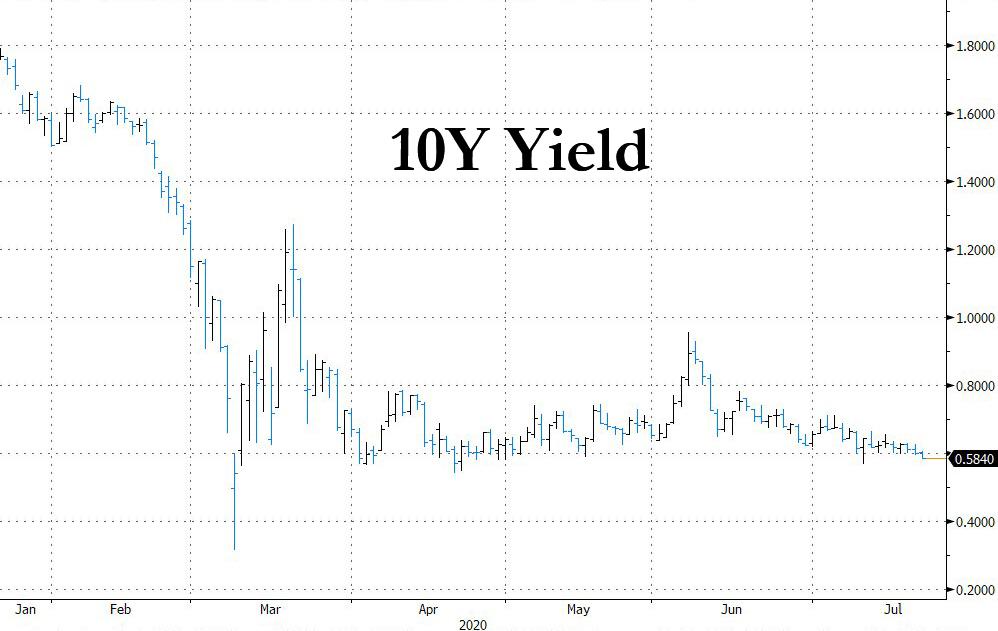“Conventional Logic” No Longer Exists: What That Means For The Treasury Market
Tyler Durden
Wed, 07/22/2020 – 14:25
By Ian Lyngen and Jon Hill of BMO Capital Markets
Two of the mainstays of investor anxiety are once again setting the tone in financial markets;
- fears the pandemic is worsening and
- devolving China/US relations.
The first has been highlighted by not only the recent surge in Covid-19 cases, but also a fresh round of concern that the autumn (and typical flu season) will represent an especially challenging period for the battle with the coronavirus. These worries have been combined with the reinstatement of lockdowns/closures and thereby undermined any lingering recovery optimism. Although to be fair, the extent of positive sentiment related to the bounce back of the global economy was already in short supply as the summer unfolds and a second fiscal stimulus deal from Washington begins to take on a more elusive quality than previously assumed. This isn’t to suggest the odds for a deal are low, rather that the scope and magnitude of the second round of stimulus appears poised to disappoint.
The State Department’s order to close China’s consulate in Houston “to protect American intellectual property and Americans’ private information” represents another step in the ongoing tension between Beijing and Washington. The Chinese Foreign Ministry spokesman characterized the move as an “unprecedented escalation” and investors are now awaiting details on any potential retaliation. It’s an all too familiar dynamic and one which the market has been relatively sanguine about, all things considered. While equity futures are off the highs, the -0.4% move is only a fraction of the reaction such a development would have triggered in January. This is, in part, due to the more significant economic ramifications from the pandemic, but it also reflects investors’ perception that a shift in the White House will make it easier for both sides to discount any escalation seen during the second half of 2020.
The Presidential election is quickly approaching on the horizon and as the nuances of Biden’s policy agenda come into focus we’ll be eager to see how resilient the bid for domestic equities remains. Conventional logic suggests if the White House is controlled by a Democrat, less pro-business policies will weigh on risk asset valuations; an influence which would only be exaggerated in the event of a blue sweep which similarly achieves control of Congress. If we’ve learned anything from 2020 (aside from the importance of washing our hands), it’s that “conventional logic” hasn’t been in the driver’s seat for a very long time.
In fact, it’s well within the set of potential outcomes that a blue sweep implies a welcome return to establishment politics which clears the way for US equities to rally into the end of the year; even if the kneejerk would be risk off. While this might initially sound somewhat counter-intuitive, the process of moving beyond the divisive political environment of the last several years could resolve into a net positive for the business community; particularly if combined with continued progress through the depths of the pandemic.
That said, the needed level of clarity on the political front will not be on offer in the Treasury market at this stage and instead, we’ll continue to trade off the incremental influences from risk assets as earnings season progresses. 10s have extended the stealth rally with yields dropping as low as 58.4 bp overnight. For context, since April 30 10-year rates have only been this low on one other occasion; July 10 – when 56.8 bp redefined the lower-bound. We’re focused on two sell levels; 56.8 bp and 53.9 bp (low from April 21). Our baseline expectation is that both levels will be sold on the first attempt and if yields manage to close above the floor, a second attempt isn’t a foregone conclusion. In the event of a shift in the macro narrative, a more durable bid could easily push through the bottom of the range and put a <50 bp 10-year yield on the table as the summer drags on.
In keeping with our range-trading thesis for Q3, we’re anticipating selling interest as rates creep lower and the fundamentals remain comparatively steady. The omnipresent uncertainties created by the pandemic will limit any significant selloff back toward 75 bp in 10s; even if low volumes and diminished risk-taking capacity clear the path for sharp price action.
via ZeroHedge News https://ift.tt/3eQKGA8 Tyler Durden
